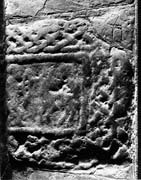Select a site alphabetically from the choices shown in the box below. Alternatively, browse sculptural examples using the Forward/Back buttons.
Chapters for this volume, along with copies of original in-text images, are available here.
Object type: Part of grave-cover [1]
Measurements: L. 49.5 cm (19.5 in); W. 53.4 > 52 cm (21 > 20.5 in); D. Built in
Stone type: Coarse-grained, very pale brown (10YR 7/4) sandstone, with some mica; see no. 2.
Plate numbers in printed volume: 861
Corpus volume reference: Vol 3 p. 219-220
(There may be more views or larger images available for this item. Click on the thumbnail image to view.)
Only one face is visible.
The surface of the slab is slightly convex. The edge moulding is extremely worn. It contains a perimeter band of plain plait, which is five-strand at the top, but too worn to be sure of the number of strands to the right and below. Within it is a modelled moulding forming a frame for the interior panel. The panel contains a hunt scene. On the left a standing profile huntsman holds a bow and arrow; a stag turns its head from him. Its legs are bent and antlers are visible. There is an indistinct form over the stag's back.
Recumbent slabs were known at an early date in Ryedale, for example, at Kirkdale (nos. 7–8). The curved top is paralleled at All Saints Pavement, York (no. 1; Ill. 201), and Haile 2 in Cumbria (Bailey and Cramp 1988, 112, ills. 340–4), both from the Viking age. The interlace frame points to no. 8 being a part of the same monument.
The iconography of the stag hunt, and its associated 'hart and hound' motif, remains a puzzle (Bailey 1977). Here the complete hunt is depicted, as on Middleton 1 (Ill. 671), though the hart and hound also appears in Ryedale at Ellerburn (no. 5; Ill. 432). The full hunt is found on Irish and Pictish sculpture (Henry 1964, pl. 22, Henderson 1967, pl. 60; Close-Brooks and Stevenson 1982, 32), but the hart and hound also occurs sometimes in a Nordic context, not least on the Oseberg plank (Wilson and Klindt-Jensen 1966, 28, fig. 2). In Northern England its appearance may be an indication of a Norse-Irish milieu.
The style of the hunt scene is naturalistic, as on Middleton 1, which normally indicates either a narrative programme or iconographic significance: for example, like the Sigurð slab from York Minster (no. 34; Ills. 142–7). The depiction of the bow is important evidence for a weapon of the period which has not survived archaeologically.



